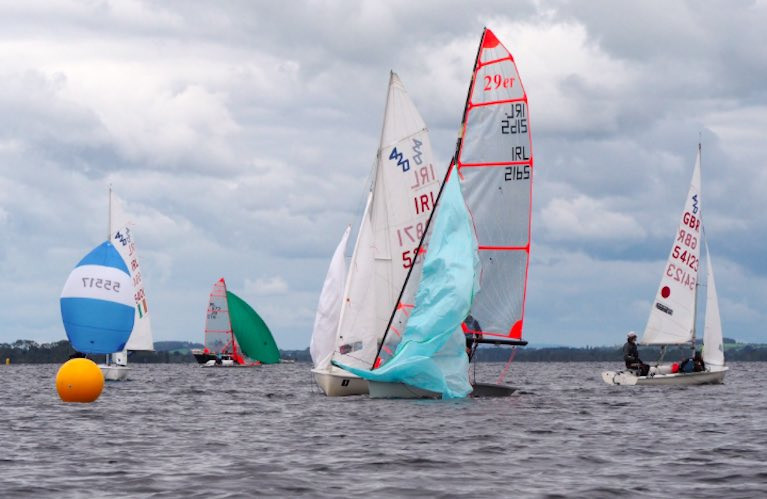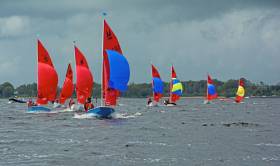Displaying items by tag: Double Ree Regatta
In an era when solo dinghy stars seem to get much of the glamour attention, Lough Ree YC's Double Ree Regatta for four leading two-handed classes on 16th-17th July is poised to meet a popular demand as the weather settles into a much more summery pattern.
For the Mirror Class, it will include the Irish Nationals from the 15th to 17th July, while the RS Fevas, 420s and 29ers will have their sailing built around a more compact formula on the Saturday and Sunday, 16-17 July.
The inaugural Double Ree in 2020 was notably successful. Now with LRYC's shoreside reception and camping facilities further developed to match an improved "product" afloat, Double Ree 2022 will be offering an attractive package to match LRYC's position as the current MG Motor "Sailing Club of the Year".
Great Success of 'Double Ree' Dinghy Regatta at Lough Ree Yacht Club
Reigning all Ireland Junior sailing champion Chris Bateman swapped his local waters of Cork Harbour for Lough Ree Yacht Club's 'Double Ree' double-handed dinghy regatta last weekend and provides this report for Afloat
On the last weekend of August 2020, Lough Ree Yacht Club held their renowned “Double Ree” sailing event. First held in 2018 and designed for the double-handed dinghy enthusiast, this event was immensely successful. That success was repeated this year, on the 29/30th of August.
On Friday afternoon, Lough Ree Yacht Club opened their gates to groups of enthusiastic competitors. With a pandemic looming overhead, masks were donned and one way systems were followed. These simple things became second nature and by the evening, tents were spread out across the fields surrounding the 250-year-old yacht club.
 Lough Ree Yacht Club's Committee Boat heads out on the lake to start racing in its 2020 Double Ree Regatta
Lough Ree Yacht Club's Committee Boat heads out on the lake to start racing in its 2020 Double Ree Regatta
Three fleets of double handers were expected this year, which meant that each arriving car carried a different boat on its roof. The cars and trailers were hastily unloaded and each dinghy was put with its own fleet, each fleet having been allocated a corner of the dinghy park. This left fifteen 420s, fourteen Mirrors, and thirteen 29ers sitting at the lakeside.
Registration was completed in a controlled manner as darkness fell over the happy campers, all waiting in anticipation for the next day.
Saturday, the first race day came around. The sailors awoke to the unique sound of the lake water lapping against the shoreline. A low sun hovered over Lough Ree, revealing a cascade of white water, churned up by a twenty-knot northerly wind. With a start scheduled for 12:00 pm, the competitors lost no time rigging up their boats despite the cold temperature. Each sail was hoisted eagerly and the scene became loud as the sails flogged in the high wind.
 Fourteen Mirrors contested Double Ree Regatta
Fourteen Mirrors contested Double Ree Regatta
The Mirror fleet launched first, braving the harsh conditions as each sailed out one by one. Even among their own fleet, the variation between boats was huge. They ranged from modern, finely tuned fibreglass constructed boats all the way to copper stitched plywood boats, beautifully finished with varnished decks and painted hulls. Their red sails were instantly recognisable as they bobbed on the short chop. Next to launch were the 420’s, who skimmed their way out of the slip, to be joined by the 29er fleet a few minutes later.
The race committee dived straight into the first race, having set a trapezoid course for each fleet to complete. In a flurry of action, each fleet set off on separate starts to begin the first race.
The dinghies battled up the course, struggling through the high, short chop. While the Mirrors had a head start, the different fleets would eventually converge with each other due to speed differences. The 29ers put on an entertaining show, with wild high-speed capsizes and general hooliganism. While yachtsmen shudder at the thought of such bad seamanship as capsizing, the three fleets showed a whole new side of dinghy racing that was fast and furious, while also very entertaining to watch!
Three races were completed that day and the battered sailors returned to shore, fit to collapse. After each fleet had battled it out on the water for over five hours, the results were set. In the Mirror fleet, overnight leaders were Matthew Fallon with crew Jonathan Flannery. In the 420 fleet, Ben Graf and Alexander Farrell were overnight leaders, while in the 29ers it was James Dwyer and Chris Bateman.
Day two began with a clear sky and a strong feeling of early winter. The wind was down and the water was calm. The fleets launched much earlier than the previous day, with a start scheduled for 10:30 am. As they sailed out to the course the wind picked up to a fickle five knots. Conditions were light and shifty, which meant that decision making on the course was crucial. The 29er fleet started first, then came the 420’s and the Mirrors. After a course change and three long races, the sailors drifted home, in what was a huge contrast to the previous day’s racing.
The light winds gave everyone a chance to appreciate the lovely waters of Lough Ree, with its green shorelines and various dotted islands. A true sailing venue, worthy of adventurers and racing yachtsmen alike. The Lough Ree Yacht Club celebrates its 250th anniversary this year, and this is where the “Double Ree” finished up, with the prize-giving held outside its front door. In the Mirror fleet (also their westerns), 1st place went to Jessica Greer with crew Mark Greer. In 2nd was Matthew Fallon and Jonathan Flannery, while in 3rd was Luke Johnston and James Boyd.
 A competitive start for the 420 fleet contesting its Connaught Championships as part of Double Ree Regatta
A competitive start for the 420 fleet contesting its Connaught Championships as part of Double Ree Regatta
In the 420 fleet, it was Jack McDowell and crew Harry Thompson in 1st, with Ben Graf and Alexander Farrell in 2nd. In 3rd place was Harry Shackleton and Cara McDowell. (See also Afloat's 420 separate Double Ree report here - Web Ed)
 A fine turnout of 29ers on Lough Ree
A fine turnout of 29ers on Lough Ree
In the 29er fleet, 1st place went to James Dwyer and Chris Bateman. In 2nd was Tim Norwood and Nathan van Steenberge, with Lauren McDowell and Erin Mcllwaine taking 3rd place.
The LRYC pulled off what many said would be impossible, which was to run a successful national event in a carefully controlled manner. By doing this, they have managed to spread enjoyment and some relief among the dinghy racing community. There was no better place to do this than on a lake such as Lough Ree, and every competitor and family that travelled to the “Double Ree” is very grateful to the people that made it happen.
#YouthSailing - Saturday 21 and Sunday 22 July are the dates to save for the inaugural Double Ree Regatta at Lough Ree Yacht Club.
The four biggest two-handed youth classes will be competing in their respective regional championships at next month’s inaugural event in Athlone, developed as an alternative to the usual focus on single-handed boats.
The Mirror Western Championship, RS Feva Inland Championship, 420 Connacht Championship and 29er Triple Crown will all be decided at Ireland’s largest youth double-handed regatta — and one that Lough Ree YC promises to be ‘an extravaganza of spinnaker-flying racing’.
The Double Ree concept has developed as an alternative to the usual post-Optimist paths of the Topper and Laser 4.7, says Lough Ree Yacht Club Commodore Garrett Leech.
Double-handed dinghies make an apt choice for many younger sailors, who may not be comfortable helming a larger vessel or may not enjoy sailing alone, among other reasons.
Double-handers like the Mirror also encourage the development of more rounded skill sets, Leech says.
“At Lough Ree Yacht Club, nearly all kids, even those who sail Optimist on the circuit, will also learn to sail in a double-handed dinghy, be this a Mirror or Feva, even Shannon One Designs.”
Getting younger sailors interested in two-handed sailing has also arrested a decline in classes that may be overlooked by those more focused on the high-performance pathway.
With various two-handed classes to move into, the question for Lough Ree was which to embrace.
“Some of our kids started to want more speed and excitement so have moved into 420s,” Leech says. “We sat and watched the development of the 29er fleet here in Ireland, and debated about the introduction of yet another class and what impact it might have on double-handed sailing nationally.
“We soon came to the conclusion that we should embrace all of these racing fleets — and hope that there would be no more introduced anytime soon.”
Leech gives credit to his Vice Commodore John McGonigle for developing the Double Ree concept, with input from Gail MacAllister of Irish Sailing.
“We hark back to days of old — when we hear about Dinghy Week in Dun Laoghaire from some of our older members, when there were huge numbers of dinghies competing in Dublin Bay.”
“So we are setting out to create an event that will pull all competitive double-handers to one location. We hope that that the various fleets will come to appreciate the merits of each other’s fleets.”
Holistically, the Double Ree event is also about “pulling families together in a fun environment”. But Leech is clear that attracting competitive youth sailors is a key goal.
Camping and mooring facilities are available at the Athlone venue, with a barbecue to welcome competitors and their families on Friday 20 July, as well as a club dinner on the Saturday evening.
For more details about the event, including details on booking a place, see the Lough Ree YC website and the event page on Facebook.






























































